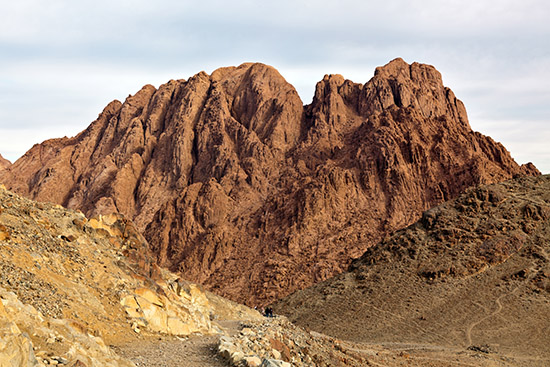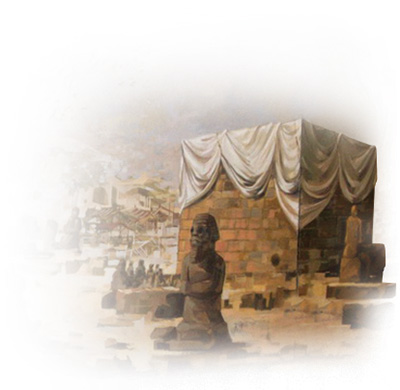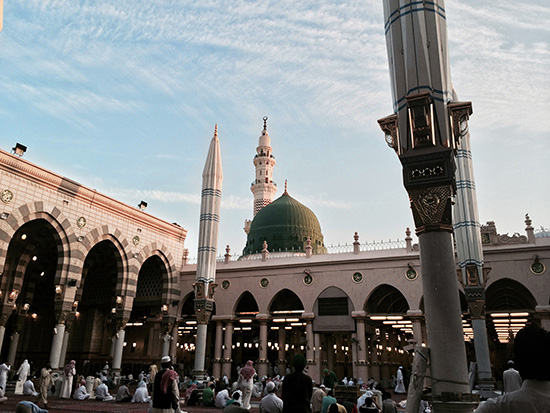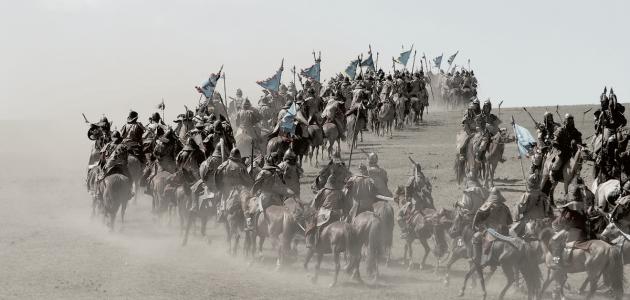Current Section: model

Lesson The Seerah (Biography) of the Prophet Muhammad ﷺ (2)
The Prophethood of the Messenger ﷺ with the Message of Islam
The Messenger of Allah's ﷺ prophethood began first with true dreams, for he would not see a dream in his sleep except that it would occur as clearly as the break of dawn.
When the Prophet ﷺ approached the age of 40, periods of seclusion became beloved to him. He would spend the month of Ramadan in the Cave of Hira by himself and devote himself to worship within it. The prophet ﷺ remained upon this for three years until revelation descended upon him during his period of seclusion that year.

When he ﷺ turned 40, he was bestowed with the light of prophethood, for Allah the Exalted honored him with His message and sent him to His creation, and distinguished him with His miracle, and made him a trustee between Him and His servants. Thus, Gabriel (peace be upon him) came to the Prophet by the order of Allah the Majestic and Exalted and made him a mercy to the worlds, and designated him for all people as a bearer of glad tidings and a warner.

As soon as the Prophet ﷺ received the command of his Lord, Glory be to Him, to convey the message by His saying: “O you who are covered up, rise and warn,” (Surat Al-Muddaththir:1-2) he immediately began calling people to worship Allah alone, and to embrace the religion that Allah the Exalted sent him with.

The Period of Secret Invitation
The Prophet ﷺ began inviting people to Islam privately as to not provoke the people of Mecca with that which will incite them against him. Therefore, he first began presenting Islam to the people closest to him from his household and friends, and presenting it to anyone who he felt good about and knew them to love truth and virtue.
The First to Accept Islam
The first to accept the religion of Islam with him was his wife Khadijah bint Khuwaylid (may Allah be pleased with her), and his friend Abu Bakr as-Siddiq (may Allah be pleased with him), and his paternal cousin Ali ibn Abi Talib (may Allah be pleased with him), and his slave Zaid ibn Haritha (may Allah be pleased with him).
Then Allah the Majestic and Exalted commanded him to invite publicly: {Then proclaim what you are commanded} (Al-Hijr:94). So the Messenger of Allah ﷺ announced his invitation to Islam and cracked open with the truth as Allah the Exalted commanded him).

When the Messenger of Allah ﷺ declared the call to Islam publicly, the leaders of Quraysh met his call by turning away and dissuading others from it in various ways: through mockery, humiliation, ridicule, and denial, all in order to demoralize the Muslims, weaken their resolve, distort the teachings of the Islamic faith, cast doubts, spread false propaganda, and to bring the Prophet ﷺ to bargain with them and abandon the call in return for certain gains.
When the polytheists saw that these methods were of no use, and that the Prophet ﷺ was continuing with his call to Islam, they decided to fight Islam, and began to harm the Prophet ﷺ and torture and persecute his companions who believed with him. When the persecution of the polytheists intensified, the Prophet ﷺ instructed his companions to migrate to Abyssinia. As a result, a number of Muslims, men and women, migrated there in the fifth year of his prophethood.

While the Prophet ﷺ was at a juncture in which his call was carving a path between success and persecution, the incident of Al-Isra' and Al-Mi'raj occurred. This incident came as a confirmation of and honoring the Messenger of Allah ﷺ after many years of preaching and patience with the abuse from the polytheists, their persecution, their rejection, and their estrangement.

The Invitation Outside Makkah
The Prophet began to present Islam outside Mecca, so he went to Taif. When he found some of them rejecting and turning away, he returned to Makkah and began to present Islam to tribes and individuals during the Hajj season.
The Two Pledges of Al-'Aqabah
In the 11th year of the mission, the Prophet ﷺ met six people during the Hajj season from the people of Yathrib---which he later named Al-Madinah---so he presented Islam to them and made it clear to them its truth. He called them to Allah the Exalted and Majestic, and recited the Qur’an to them. They embraced Islam then returned to Al-Madinah and called their people to it, until Islam spread among them. This resulted in some of the new Muslims of Madinah attending the First Pledge of Al-'Aqabah, which took place on the Hajj season of the 12th year, followed by the Second Pledge of Al-'Aqaba in the following Hajj season of the 13th year of prophethood and it was kept secret. Upon its conclusion, the Messenger of Allah commanded the Muslims of Makkah with him to migrate to Al-Madinah so they left.
After the majority of the Muslims emigrated from Mecca, the Messenger of Allah ﷺ and Abu Bakr (may Allah be pleased with him) emigrated to Medina. However, they left in the opposite direction to blindside and confuse the Quraysh regarding the matter. They both descended upon the Cave of Thawr and spent three days in it. Then they set out towards Medina using an unfamiliar path near the coast of the Red Sea. When the Prophet ﷺ and his companion reached the outskirts of Medina, the Muslims welcomed him in a solemn procession full of joy and pleasure.

The first thing that the Prophet ﷺ did when he arrived in Medina was to build the Prophet’s Mosque and to establish fraternity and brotherhood between the Muhajireen (migrators from Makkah) and the Ansar (Muslim residents of Medina), thus laying the foundations for the new Islamic society.

After the migration to Medina, the laws of Islam were successively revealed, such as Zakat, fasting, Hajj, jihad, the call to prayer, enjoining good and forbidding evil, as well as other legislation.
Allah the Exalted sent down permission for Muslims to fight in order defend their religion and their state, and to spread the eternal message of Islam. So the Exalted said: {Permission [to fight] has been given to those who are being fought because they were wronged} (Al-Hajj:39). This was the first verse revealed granting permission to fight. The Messenger of Allah fought in a total of 27 military campaigns and sent 56 military campaigns that he sent without attending.

The most important events that occurred after the emigration to Medina
The following is a brief presentation of the most important events that occurred after the Prophet's emigration to Al-Madinah Al-Munwarrah
The First Year of the Hijra:
The 2nd Year of the Hijra
Instituting the obligation of zakat, fasting, and the major Battle of Badr, in which Allah honored the believers, and gave them victory over the disbelievers of the Quraysh.
The 3rd Year of the Hijra
The Battle of Uhud in which the Muslims suffered defeat for violating the instructions of the Prophet ﷺ by descending from the Archer's Mountain to collect the spoils.
The 4th Year of the Hijra
The Battle of Banu al-Nadir in which the Messenger of Allah ﷺ expelled the Jews of Banu al-Nadir from Medina for breaking the covenant between them and the Muslims.
The 5th Year of the Hijra
The Battle of Banu al-Mustaliq, the Battle of al-Ahzab (The Parties) and the Battle of Banu Quraydha
6th Year of the Hijra
Treaty of Hudaybiyyah between the Muslims and Quraysh
7th Year of the Hijra
The Battle of Khaybar. During this year, the Messenger of Allah ﷺ and the Muslims entered Mecca and performed their make-up Umrah.
8th Year of the Hijra
The Battle of Mu'ta between the Muslims and Romans, the Conquest of Mecca, the Battle of Hunayn against the tribes of Huwazin and Thaqeef
9th Year of the Hijra
The Battle of Tabuk, which was the last battle in which the Prophet ﷺ participated. During this year, many delegations came to the Messenger of Allah ﷺ and people accepted the religion of Allah in droves. This year was dubbed the Year of Delegations.
9th Year of the Hijra
The Farewell Hajj (Pilgrimage), in which more than 100,000 Muslims performed Hajj with the Prophet ﷺ
When the Prophet's call to Islam was completed and Islam spread throughout the Arabian Peninsula, people entered the religion of Allah in droves, and the light of its spread began to appear in the world, overshadowing other religions, the Messenger of Allah ﷺ sensed the approach of his time in the world. So he began preparing to meet his Lord and his words and actions appeared to indicate his approaching departure from this mortal world.

On the 11th year of the Hijra (AH), the Messenger of Allah ﷺ passed away on Monday the 12th day of the month of Rabi' al-Awwal.
He ﷺ died at the age of 63 spending 40 years of his life without prophethood and 23 years as a prophet and messengers. From the 23 years, he spent 13 years in Mecca and 10 years in Medina.
Even though he ﷺ passed away, his religion remained. By his death, there was not anything virtuous except that he guided the nation to it, and there was not anything evil except that he had warned his nation against it. The virtue that he guided to was monotheism and everything that Allah loves and is pleased with. The evil that he warned against was polytheism and everything that Allah hates and detests.





